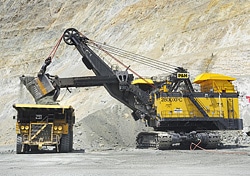A new multi-million dollar research effort headquartered in Australia may be the answer to uncovering those deeply buried mineral deposits that we all know are there but, to date, have been next to impossible to find.
Starting in January 2010, the deep exploration technologies program launched by Australia’s Cooperative Research Centre (CRC) will attempt to address the global problem of resource depletion and declining exploration success by finding ways to drill deeper and better capture data from several hundred metres under the surface.
Australia’s ministry for innovation, science and research is contributing AU$28 million to the program, while industry partners have committed a similar amount that is expected to grow as more companies join the initiative.
“The program is open to anyone around the world who wishes to participate as a partner,” says Joe Cacuzza of AMIRA International, the industry association that spearheaded the initiative. “From a research standpoint, we are interested in hearing from anyone doing research work in drilling and related technologies that would apply to the hard rock environment.”
Service providers and equipment manufacturers are also encouraged to join the group and provide in-kind support. For example, Boart Longyear, one of the core partners, is providing access to people and equipment. The international drilling company also represents an important route to market for any of the technology that is developed through the program.
Finding deep deposits requires deep drilling, but costs, environmental impacts and safety risks have restricted the depth to which drillers are willing and able to go. The CRC hopes to overcome these barriers with research and development that will: reduce the time and cost and increase the safety of drilling exploration holes down to two kilometres and more; increase the value of those holes by collecting more useful data from them; and optimize the space between the holes to maximize that information.
Some examples of the technology CRC expects to develop include front-of-the-bit tools and geoimaging software to help drillers respond to changes in rock as they work, downhole sensors that can generate on-site information about ore mineralogy, and software to produce 3D representations that combine geometrical and mineral information.
The research idea was first conceived at AMIRA’s exploration managers conference in March 2007, an invitation-only meeting that brings together executives and research and technology managers to discuss exploration research. AMIRA then prepared a formal CRC bid that was accepted in August, 2009.
The program is expected to run for eight years and will be extended provided industry support continues.





